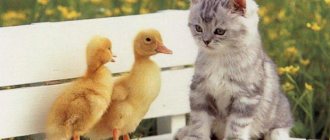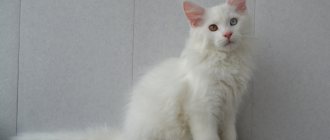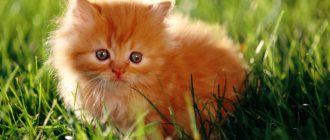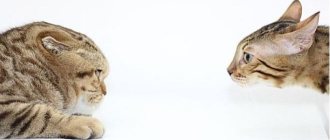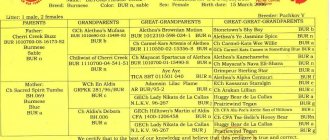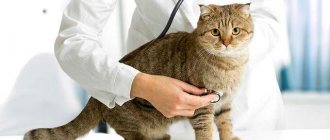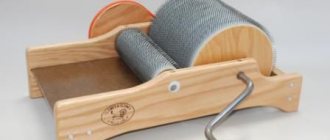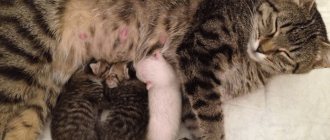Main characteristics common to all types of Abyssinian color
If you look closely at the fur of an Abyssinian cat, you will notice that on each of its hairs the dark color gives way to light.
Attention : in the standard color, one hair of an Abyssinian cat must have at least three stripes.
In standard colors, Abyssinians do not have a clearly defined pattern on their fur coat. The hair of this breed is short and close to the body. The undercoat is always several shades lighter than the main color.
Abyssinian cat colors according to international standards, the main characteristics include:
- dark stripe on the back and tail;
- necklace in the neck area;
- absence of a pronounced pattern on the head (except for the blue color).
Types of colors
Selection work on representatives of the British breed, involving various bloods, has led to a variety of both colors and breed types. If initially the British had short hair with a thick undercoat, then crossing with the Persian cat made it possible to obtain semi-long-haired animals. The colors of British longhair cats correspond to the colors of shorthair cats.
Many people only think of Britons as smoky, blue or tabby cats and don't even realize how many colors the breed has. Even a pair of quite ordinary parents can produce a kitten of a rare color.
To organize the variety of colors of British cats, they are divided into types and groups according to color, pattern and method of pigmentation.
Types of colors of British cats:
- solid (or plain);
- typed: smoky, veiled, shaded;
- gold;
- silver;
- tortoiseshells;
- color point;
- particolors: harlequin, bicolor, van, mitted;
- tabbies: spotted, striped, marbled, ticked.
A table of the colors of British cats will help you imagine all the diversity.
Colors of Abyssinian cats included in the breed standard
In total, there are only 4 colors of Abyssinians, which are accepted by the world Association.
Important : adult Abyssinians reach maximum hair coloring at the age of one and a half years, after the first spring molt.
Classic wild
Initially, this was the only standard color of the Abyssinian. It is still in greatest demand today and is considered the most widespread. The classic shade combines rich brown and black tones.
Abyssinian cats of classic wild colors have:
- uniform ticking of 3 segments;
- dark brown color of the back and sides, in contrast to the lower part of the body;
- dark brown paws;
- black stripe on the back;
- a clearly defined nose of reddish-red (brick) color.
Please note : all Abyssinian kittens are born with blue eyes. And at 10 months of age they change their color.
Blue
This color became standard quite recently. The coat of the Blue Abyssinian is gray-beige with a pronounced silver tint. The main requirements for this color are:
- presence of a pattern on the muzzle;
- light beige tone of fur on the belly and chin;
- a small stripe along the back with a pronounced blue color;
- brick-colored nose with a clearly defined contour;
- lighter shade of undercoat, but not white.
Faun
This color is quite rare among Abyssinians. Outwardly, it is similar to sorrel, but not as rich and pronounced. The Abyssinian faun looks very noble and elegant.
Abyssinian kittens of wild color - a charming savage
Photo of an Abyssinian kitten from the Abysphere nursery.
This is the most common color option among Abyssinians; the word ruddy is translated from English as “ruddy.” Wild Abyssinian kittens have a brown-ocher undertone combined with black or dark brown ticking. A contrasting dark line runs along the back, ending at the tip of the tail, which has the most intense color. The nose is terracotta colored and has a dark edging, and the paw pads are ticked in color.
Colors that are not included in the standard
In addition to the four main colors included in the breed standard, there are other colors of cats.
Black
The black Abyssinian looks elegant and impressive. Despite the fact that such cats are not included in the standard, they are very popular among people. Their fur is dark chocolate or black and gray in color, and their belly can be brown or gray. But black Abyssinians are quite rare. Since they are difficult to obtain by breeding.
White
Abyssinians can get white color:
- under the influence of the recessive albinism gene. In this case, a white kitten with blue eyes is born;
- with large white spots. As a result, the cat is not completely white, but it is dominant;
- with a dominant white color. In this case, the white gene (W) is completely dominant.
Chocolate
This is one of the most common colors, despite the fact that it is considered unrecognized. The base of the fur of chocolate cats is golden or copper, smoothly turning into apricot, and then into dark chocolate color. Paws are plain and brown.
Lilac
The fur of the Lilac Abyssinian has a soft, warm gray tone. And the purple effect itself is formed due to the ticked tone of the hairs. At the base of the coat there are creamy pink or soft cream hairs that smoothly turn into gray. Abyssinians of lilac colors always have pale pink nose and paw pads.
Silver
Gray Abyssinians are characterized by a ticked coat, characterized by a subtle transition from silver to blacker. At the base, the hairs have a gray tint, which then turns into a shiny steel tint. And the tips of the fur themselves are darker and almost black.
The paws of Abyssinians are silver and have a solid black color. The color of the nose can vary from dark pink to red. It depends on the main rich color of the cat. Quite often, silver Abyssinians are born with defects: spots or stripes on their coat. But this does not matter to the owners, since they are not included in the breed standards anyway.
Tortoiseshell colors
Spots of two colors are evenly distributed throughout the body.
rich color (black, chocolate or cinnamon) with red, as well as blue (or purple) with cream.
The colors are distributed equally and look harmonious. The thick coat is short and soft.
The paw pads are pink or black, and the eyes are copper and gold shades. Cream slippers on the paws or short stripes on the nose are possible.
British Chocolate Cream Tortoise
British blue-cream tortoise
British cat lilac-cream tortoiseshell
Photo of a British black tortoiseshell cat
This color occurs only in female cats; due to the peculiarities of genetics, cats are not tortoiseshell.
Tortoiseshell variety of color? These are combinations of spots of solid color that leave a mosaic pattern on the cat’s fur in various combinations. Intense solid colors?
This type of coat color is characteristic only of cats.
The tortoiseshell coat color appears gradually. A newborn kitten may have a few spots, but as they grow, the number will increase. Young British cats may have a gray undercoat or a somewhat muted red tint, but the final color develops by the age of one year.
Tortoiseshell cats are rightfully considered the queens of any cattery, because... they can produce offspring with a variety of colors.
Black turtle
This is a harmonious combination of proportional red and black spots of different shades. The hairs are dyed evenly. Black color should be saturated, and red, accordingly, bright and intense. Both shades should be present on the paws and head of British tortoiseshells. According to the standard, mixed spots are acceptable. A red “tongue of flame” (scorch mark) on the muzzle would be desirable. It is not desirable to have patterns on red spots.
Chocolate turtle
It is a combination of chocolate and red shades in identical mosaic proportions. The general requirements are the same as in the previous case: intense, saturated color, harmony in arrangement, evenly colored hairs, tan on the face and absence of a pattern.
Undesirable color deviations
The Abyssinian breed has certain standard colors that appear at the age of 4 months. And at first, the kittens’ coat is fluffy and has an inexpressive faded color. As they grow older, the coat becomes more pronounced and fully complies with color standards.
Attention : pronounced patterns on the coat of the Abyssinian are considered a defect. Although, according to international standards, small white spots on the chin and collar are allowed.
The most common color deviations in Abyssinians are:
- different shade of paw pads from the main color of the coat;
- lack of black eyeliner around the eyes;
- the presence of dark spots or patterns on the face;
- lack of a necklace around the neck;
- too bright contrast between the main tone of the coat and the undercoat;
- absence of a dark stripe on the back or tail.
A lighter color of the lower part of the body in the base color is allowed. But the undercoat of purebred Abyssinian cats must exactly match the main color tone, but it can be a little lighter or brighter.
Important : the presence of dull or gray undercoat tones in Abyssinian cats is unacceptable.
Blue Abyssinian kitten - mountain lion
Photo of an Abyssinian kitten from the Incendie Etoile cattery.
The soft blue color in the case of the Abyssinian breed is a lightened version of the wild color.
The blue Abyssinian kitten is incredibly beautiful - the lower part of the body is colored pinkish-fawn, and the upper part is gray-blue. The dark stripe on the back is a deeper shade of blue. The nose is the color of a dusty rose, and the pads of the paws are purple, with a bluish edging between the toes.
What determines the color of the Abyssinian
The unusual and original colors of the Abyssinians are their calling card. This is due to the presence of several genes in their genotype, the dominance of which determines coat color.
Genes responsible for coat color
The following genes are responsible for the coat color of Abyssinians:
- Agouti "Ta" gene. It determines the presence of ticked hairs on the fur;
- "Ttb" gene. With its dominance, kittens are born of a “tiger” color;
- “U” gene. When it is dominant, there is no clear pattern on the coat.
The color of a purebred kitten largely depends on the combination of genes planned by the breeders. Kittens may be born with patterns on their fur that will disappear on their own as they grow older.
Attention: the presence of a gray and faded undercoat on a kitten indicates a crossbreed.
Despite the fact that the presence of white spots on the face, belly, paws and tail is not considered a defect, they try not to use such cats for breeding.
Genes responsible for color tone
Looking at the colors of an Abyssinian cat, you can see that they are formed not only due to their own color, but also due to the tone of this color. That is, the dominant gene in them is the D gene, and its recessive companion is d. Together these genes give a rich dark or lightened color. The dominance of genes is manifested due to their combination:
- a combination of DD or Dd genes produces dark tones;
- the combination of recessive genes dd is responsible for the light color.
In other words, the Abyssinian wild color is obtained through a combination of black color and rich tone. That is, a pair of DD or Dd genes. The Abyssinian blue color is obtained due to the combination of black and light tones, namely the dd genes.
General information
Within the Abyssinian breed, four color options are considered universally accepted, which can be divided into two groups: saturated and lightened. All these colors have a warm undertone.
| Saturated | Lightened |
| Wild (Ruddy) | Blue |
| Sorrel | Fawn |
In addition, some felinological organizations have adopted such options as chocolate, lilac, cream, tortoiseshell, as well as their silvery, “cold” variations, but they are quite rare.
What is unusual about the main Abyssinian colors? All of them belong to the group of patterned, or so-called tabby colors. But instead of the usual stripes, due to the agouti A gene, the color of Abyssinian cats is manifested by zonal coloring of the hairs, which is called ticking. That is, each hair has alternating light and dark areas - as a rule, there is a light area near the skin, then a dark one, then a light one, and finally a dark tip.
Due to such an interesting distribution of pigment, the Abyssinian cat’s fur looks as if it were powdered. When the cat is in motion, the ticking plays effectively in the light and shimmers with all its shades. The Abyssinian breed standard requires double or triple ticking, but the latter is extremely rare.
What else is unique about the Abyssinian color? Because genetically all Abyssinians are not red at all, but black! It is the black pigment eumelanin that is responsible for all this Abyssinian splendor. Depending on the set of genes and how the pigment molecules are distributed, the color turns out to be saturated or lightened. Let's look at each of them separately.
How do eye color and coloring relate?
The eye color of Abyssinian cats directly depends on the main color of their coat:
- Abyssinians of wild colors have eyes of hazel, golden or green;
- The Abyssinian faun cat has eyes that strictly correspond to the standard color. Their color can vary from golden to green;
- The Abyssinian sorrel is most often found with golden or copper eyes. Although green or dark hazel eyes are allowed for this color;
- The blue Abyssinian has golden and copper eyes. Green and nutty shades are less common.
Silver and gold
Silver color is one of the most popular among British cats. It can be of the following types:
- shaded;
- veiled;
- smoky;
- tabby
Golden color is also not found in its pure form. This bright color is one of the most expensive among British cats. It can be represented by the following types:
- shaded;
- veiled;
- tabby
Ticked tabby, shaded and veiled colors are called chinchilla. It is the representatives of golden and silver colors that are called chinchilla and golden chinchilla.
Abyssinian cat fur care
Abyssinian cats are ideal for indoor keeping. They have good health, practically do not shed (thanks to their short hair), are completely unpretentious in food, and do not cause any trouble to their owners.
But they, like any other purebred cats, need to be provided with proper coat care:
- Once or twice a week, your pet must be combed with a special comb with metal teeth;
- During the spring molting period, it is recommended to periodically bathe cats and brush them frequently;
- For bathing Abyssinians of all colors, a special shampoo is used, and the water is changed 2-3 times during the bathing process. This breed loves to swim, but hates showering.
In order for your pet to have perfect fur, it needs to have a proper diet, be given the opportunity to exercise a lot and keep it clean.
In conclusion, it is worth noting that Abyssinian cats are distinguished by: their regal coloring, the arrogant look of their huge expressive eyes, and their nobility. They conquer their owners with obedience, friendliness, affection and warmth. This breed is characterized by loyalty and affection for its owners, and does not tolerate loneliness at all. Therefore, if you are often not at home, it is recommended to get two cats at once, and not necessarily of the same breed. Instead of a cat, you can get any other pet (just not a parrot or rodents), since Abyssinians get along well with all animals and always try to find contact with them.
Character and description of the breed
The Abyssinian cat is distinguished by its good-natured character and reverent attitude not only towards one owner, but also towards all family members. This breed also gets along well with other pets. Therefore, cats, dogs, parrots and other types of animals can become good companions for the Abyssinian.
The breed rarely shows its aggressiveness, but persistently demands a gentle attitude and respect for itself.
The cat becomes strongly attached to the family in which it grows. She does not like loneliness, so she is always nearby, as if taking part in all household chores.
The Abyssinian is known for its excessive activity, which not every owner likes. But when purchasing such a pet, you need to remember that it cannot be re-educated. Excessive energy has been ingrained in him since childhood. He is very curious and likes to explore his territory often.
Distinctive qualities of cats:
- loyalty to the owners;
- developed intelligence;
- the ability to learn quickly (strangely enough, the Abyssinian can be taught simple commands, for example, “place”, “here”, “on”);
- good character;
- playfulness (the cat often finds something to do, switching from one fun to another).
Abyssinian cats are characterized by independence. They will not sit quietly on their owner's lap unless they want to. Such cats prefer to purr quietly rather than scream annoyingly.
This is a fairly ancient breed, whose homeland is considered to be Ethiopia. Such an ancient animal can still be seen in pictures of the pharaohs. The images clearly conveyed the gracefulness of the breed, royal bearing and charm. The Abyssinian was considered a sacred cat, so it lived only with the pharaoh or his close relative.
How to choose a kitten
The cost of an Abyssinian cat kitten, depending on the pedigree and color, ranges from 10,000 to 50,000 rubles . In some cases, kittens from reputable breeders are sold at a price of 80,000 rubles, depending on the class of the kitten.
Pet class are kittens with defects in appearance, which are prohibited from being used for breeding.
Breeding class - cats acceptable for mating, but not for participation in exhibitions.
Show class - kittens with a desirable appearance that can become participants in exhibitions.
The most expensive kittens are the top show class. They are distinguished by their impeccable appearance and flexible character. They are the ones who determine the future of the breed and are desirable for mating.
The best age to buy a kitten is 12 weeks and older . At this age, the kitten can already be weaned from its mother and undergoes all the necessary medical procedures, so it can be taken home without fear.
It is better to choose kittens from reputable breeders or nurseries. By 3 months, the kitten should have 2 vaccination marks. The cat's passport must indicate the pedigree. Pay attention to whether your kitten is intended for breeding the breed (such kittens are significantly more expensive) and how many inbred matings are in its pedigree (preferably no more than 4).
History of the origin of the breed
The royal breed keeps many secrets. The first representative of this species was mentioned in history in 1907. Then such solar cats were brought to the USA from Asia, and actively took part in international exhibitions. The first Abyssinians had peculiar tassels on their ears and striped paws, which gave them an exotic appearance. Thanks to such distinctive features, they were often associated with ancient Egyptian cats.
During the war period, this species was practically destroyed, but the breeders did not allow the cats to disappear without a trace. And in 1935 they began to be actively bred in the USA.
Today, the Cat Fanciers Association has included this breed in the top five pedigreed cats.
Similar breeds
If you have not yet decided on purchasing this breed, you can also consider similar species.
For example, the Somali cat is similar in appearance to the Abyssinian cat.
The Bengal breed is similar in character and activity.
Below is a summary of the most basic knowledge necessary to understand how the color of a cat in general and an Abyssinian in particular is formed.
There are four generally recognized colors of Abyssinian cats: wild, sorrel, blue and fawn. The most common and popular is the wild color.
Health and illness
Even with the best care, your pet can get sick. As for the Abyssinian breed, they suffer from multiple hereditary diseases.
What does an Abyssinian suffer from?
- Hyperesthesia syndrome - the cat suffers from increased pain sensitivity and reacts inadequately to touch.
- Atrophy of the retina, as a result of which the pet can become completely blind.
- Dislocation of the knee joints.
- Kidney pathologies leading to loss of appetite and constipation or diarrhea.
- Allergic reactions are common to food.
- Gum diseases. Abyssinians are prone to gum disease.
In this regard, Abyssinian cats need an annual preventive check, which costs approximately 1,500 - 3,500 rubles.
